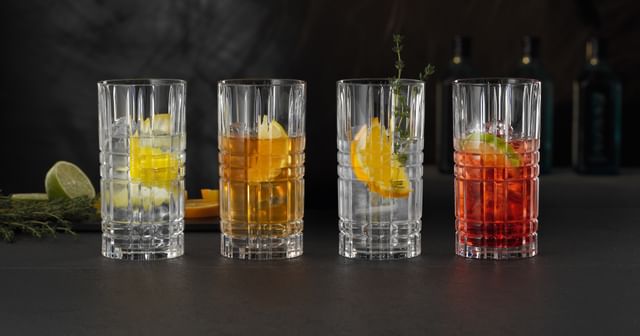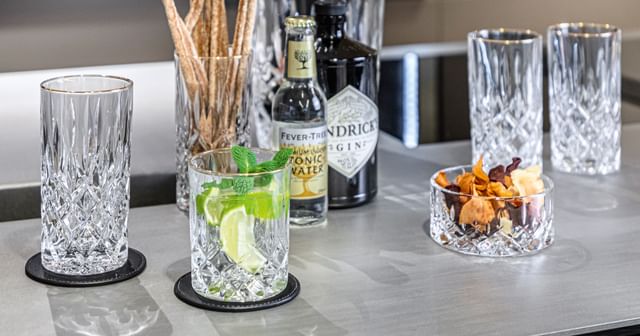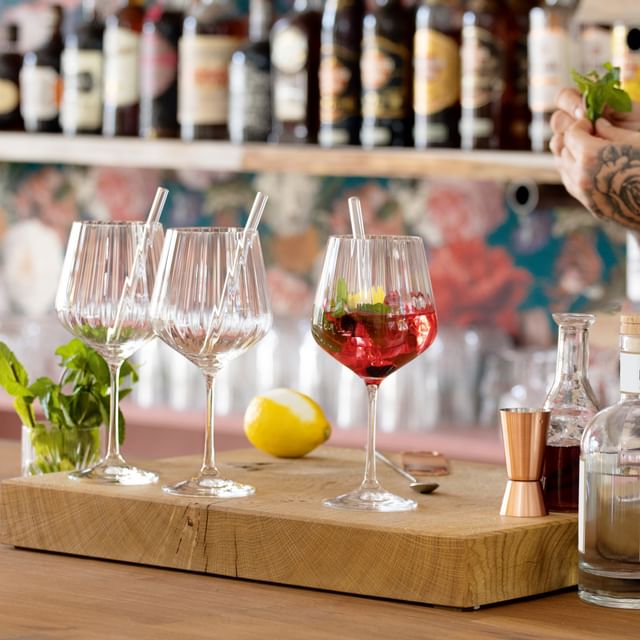From highball to gin balloon
The Evolution of the Gin and Tonic Glass

The gin and tonic is one of the most famous and recognizable beverages in the world. As the popularity of this drink and the way we approach cocktail drinking has changed over time, so has the glassware from which we sip our G&Ts. Learn all about how the G&T glassware has evolved over the years, plus which style we recommend using to allow your gin and tonic to thrive.
The history of gin and tonic glasses
Gin is thought to have been around since the mid-16th century, but it was in the 1850s - around the time when tonic water was patented - that gin and tonic as a specific beverage emerged. The G&T was invented by the British in India, initially as a means to help prevent and treat malaria, due to the medicinal properties of quinine - a key ingredient in tonic water at the time. Quinine has a harsh, bitter taste, which made tonic at the time unpalatable, so gin, lime, and sugar were added to the mixture to make it a little easier to drink.
Since its origins nearly two centuries ago, the gin and tonic has been served in a range of different glasses, with the popularity of the G&T glasses mirroring broader trends in cocktail culture. The most popular and recognizable glasses that have been widely used for gin and tonic over the years are as follows:

The highball glass
Due to its liberal use of tonic, the gin and tonic is often referred to as a highball cocktail, so it's no surprise that highball glasses (also known as long drinks) have been such popular vessels for serving them over the years. Practical and straightforward in design, the highball glass was widely adopted for gin and tonic in the 1900s as it allowed for a balanced spirit-to-mixer ratio. At the same time, its tall shape showcased the clarity and bubbles of tonic water. Despite its tall, relatively narrow structure, the highball glass still provided enough room for ice cubes to keep the drink cold.

The old fashioned glass
While typically associated with more spirit-forward cocktails that use a smaller proportion of mixer, the old fashioned glass (also known as a lowball glass or a rocks glass) has also been a popular glass for serving gin and tonic in over the years. These short, wide, and sturdy glasses became widely used for gin and tonic in the mid-to-late 20th century, and they're not without their practicalities. The wide opening allows for plenty of ice, the glass's sturdy structure makes it easier to muddle garnishes directly inside the glass, and the shape is well-suited to making stronger gin and tonic ratios. However, the old fashioned glass's wider opening and shorter stature also facilitate a faster release of CO2 from the tonic, meaning G&Ts lose their effervescence more quickly. The smaller capacity of these glasses also makes them less ideal for people who enjoy their G&Ts with plenty of tonic.

The gin balloon
The gin balloon, also known as the Copa de Balon, was invented in the Basque region of Spain way back in the 1700s as a red wine glass, but grew in popularity as a gin and tonic vessel in the late 20th century as gin and tonic became appreciated more as a sophisticated and versatile drink. With its stem (though stemless versions do exist), wide bowl, and narrowed opening, the gin balloon has become a favorite of bartenders and mixologists thanks to its dynamic aesthetic and complementary impact on the expression of gin and tonics. This glass's popularity was further boosted from the 2010s onward, as the craft cocktail movement saw cocktails shift away from universal glassware and towards more drink-specific cocktail glassware.

The benefits of using a gin balloon
Needless to say, we're pro-using a large bowl glass for your gin and tonic. While the emergence of larger, wine glass-like gin and tonic glasses have reflected the wider shift in cocktail culture, their surge in popularity is due to more than just changing trends - they make for a better-tasting G&T in the following ways:
- Holding your gin and tonic glass by its stem allows you to keep it chilled, rather than warming it up by having the bowl in your hand.
- A wide bowl provides a large surface area for your G&T, allowing your drink's aromas to develop. The narrower opening then helps the glass to contain these aromas, allowing you to appreciate them fully.
- A wide bowl also provides ample space for ice and garnish in your gin and tonic, which can considerably elevate your gin and tonic drinking experience.
While more angular in design than the traditional rounded gin balloon, our 102892 was engineered with all of these qualities in mind with one purpose: to allow you an optimal sensory experience of each and every gin and tonic you enjoy. The glass also features an optical effect created by the glass's vertical lines, which allow it to interact better with light, helping it dazzle and glisten during any occasion.
All in all, gin and tonic glassware has gone through quite the development in recent years. While we recommend glasses like our Nachtmann Celebration Gin and Tonic Glass if you aim to maximize the quality and aesthetic of your gin and tonic, you'll still see a variety of glasses used for serving G&Ts when you venture into bars and restaurants. The choice of glass can reflect personal style, the specific type of gin being used, the occasion, or simply convenience. Fortunately, if you prefer a long drink or a shorter tumbler for any reason, we also have you covered in those departments.
Locations